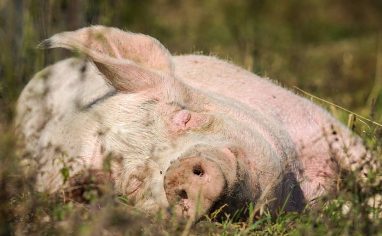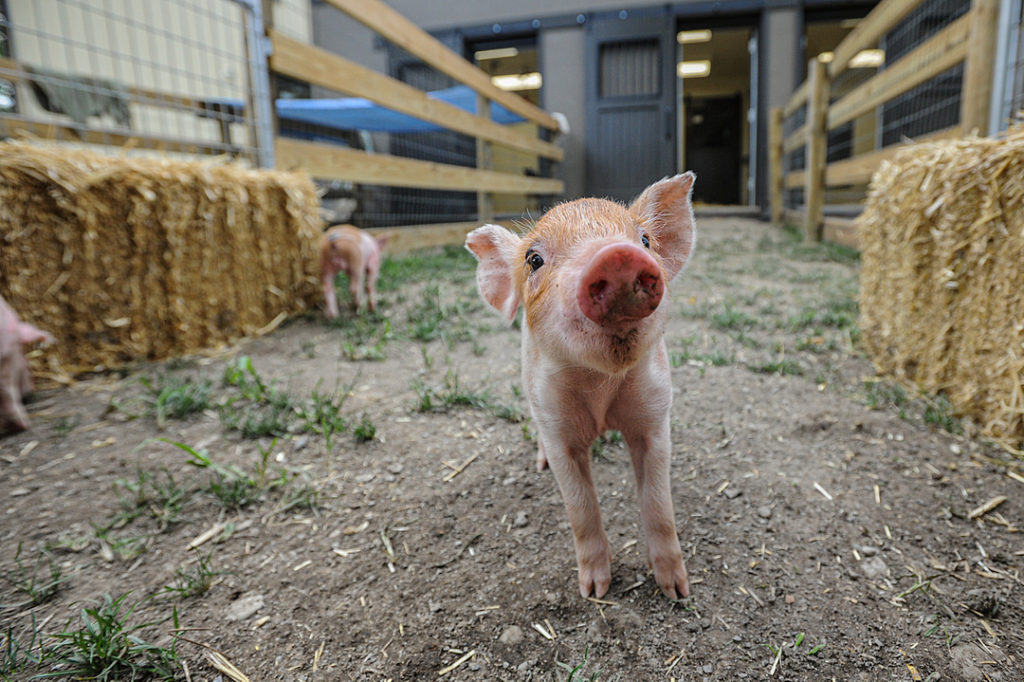
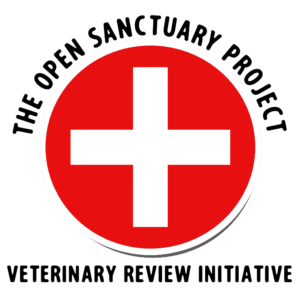
Veterinary Review Initiative
This resource has been reviewed for accuracy and clarity by a qualified Doctor of Veterinary Medicine with farmed animal sanctuaryAn animal sanctuary that primarily cares for rescued animals that were farmed by humans. experience as of August 2022. Check out more information on our Veterinary Review Initiative here!
Like other baby animals, piglets (baby pigs) have their own set of care needs that differ from the care needs of mature pigs. Understanding these needs and ensuring you are meeting them is imperative if you are to take on the care of a piglet (or piglets).
Piglets Need Their Mothers
There are a multitude of reasons a sanctuary or compassionate caregiverSomeone who provides daily care, specifically for animal residents at an animal sanctuary, shelter, or rescue. may find themselves in a situation where they must care for a piglet who is without their mother, but these reasons often differ depending on whether or not the individual is a large breedDomesticated animal breeds that have been selectively bred by humans to grow as large as possible, as quickly as possible, to the detriment of their health. or mini breed piglet. Within farming contexts, babies of all species are routinely taken away from their mothers at a time when they still depend on them for food, comfort, and safety. While we are, of course, vehemently against this practice, it is unfortunately considered “standard.” Therefore, while there are certainly exceptions, it is often the case that very young large breed piglets arrive at sanctuary without their mother.
Mini breed piglets, on the other hand, while still commodified in the sense that they may be seen as novelty “petsAnimals who spend regular time with humans in their home and life for companionship or human pleasure. Typically a small subset of animal species are considered to be pets by the general public.” to be bought and sold, are often allowed to remain with their mother until the time at which they are weaned. While we at The Open Sanctuary Project are against all breeding, within the mini pigThe term “mini pig” is used to categorize smaller breeds of pigs, such as Potbellies, Julianas, and Kunekunes, and to differentiate between these breeds and large breed pigs, such as Yorkshires, Landrace, or Hampshires, who are sometimes referred to as “farm pigs”. The descriptor “mini” can be a bit misleading- some breeds of mini pigs can weigh over 200 pounds! Terms like “teacup”, “micro”, “pocket”, “nano”, and “micro mini” are deceptive terms that are sometimes used to intentionally mislead people into thinking an individual pig will remain a certain size. community, keeping babies with their mother until they are weaned at 6-8 weeks of age is considered best practice and a sign of a “responsible” breeder. Despite this, there are reports of breeders selling “underage piglets,” and based on information from the mini pig community, it seems this practice is becoming more common, much to the detriment of the pigs.
We want to stress that piglets (and all babies, for that matter) should only be separated from their mother when it is in the best interest of the mother or babies. It should never be done out of convenience or to accommodate a human’s desire to raise “bottle babies.” When there is reason to consider separation (such as due to a health issue or the baby requiring nutritional supplementation), every effort should be made to keep the piglet with their mother whenever possible and safe for both the piglet and their mother. While this resource is not solely focused on the care of “orphaned” piglets, a good portion of this resource pertains to caring for piglets who are without their mother so that folks who find themselves in situations where they have to care for these individuals will have the information they need to do so.
Sanctuary Intake Recommendations For Piglets
Whenever you welcome a new resident to your sanctuary, it’s critical to follow appropriate intake and quarantine* guidelines in order to protect your new resident and the existing herd. When it comes to welcoming piglets to your sanctuary, intake protocols will depend on many factors including the piglet’s age, their health, their history, and whether or not they are still with their mother.
*QuarantineThe policy or space in which an individual is separately housed away from others as a preventative measure to protect other residents from potentially contagious health conditions, such as in the case of new residents or residents who may have been exposed to certain diseases. For Piglets Coming From Industry Settings
While proper quarantine is important for all incoming piglets, it is imperative when taking in piglets who are coming from industrial farming settings because of the potential disease(s) new piglets could be harboring. In addition to preventing disease spread via direct contact or contact with contaminated fomitesObjects or materials that may become contaminated with an infectious agent and contribute to disease spread (such as shoes, clothing, or tools), we recommend that your quarantine set-up also prevents the risk of airborne transmission.
Initial Assessment
Upon arrival, new piglets should be evaluated, and your veterinarian should be consulted if they are showing any signs of concern. If you do not have experience assessing the general health of piglets or are at all unsure about whether or not a new piglet appears to be healthy or not, you should have them evaluated by a veterinarian. Prompt recognition and response to health issues is imperative for neonates.
For their first few days of life, piglets will mostly just eat and sleep, but after those first few days, piglets should be active even at non-feeding times (though they will typically nap after a meal). The skin of a healthy piglet will appear shiny and tight with smooth hair. Dull, loose skin is a sign of concern, as is a sunken belly or sunken eyes. Piglets showing these signs or who are lethargic, will not eat, have diarrhea, or are not urinating and defecating should be seen by a veterinarian immediately. We also recommend that individuals coming from situations such as neglect cases, transport accidents/escapes, and other situations where the individual is at high risk of having suffered an injury or being health-compromised be evaluated by a veterinarian upon arrival, even if they appear healthy upon intake.
Initial Care For Newborns
Piglets are born without antibody protection and require colostrum (the first milk produced by a mother after giving birth) in order to receive the protective immunoglobulins they need to fight off disease (this is referred to as passive immunity). There is only about a 24-hour window for the piglet’s intestinal lining to be able to absorb the colostrum’s antibodies, with the first 6 hours after birth being the most effective absorption time and an exponential loss in effectiveness as the day goes on. Ideally, colostrum should be fed within the first 12 hours of life.
Without colostrum, piglets are left with little protection from disease, so if you take in a piglet who is less than 24 hours old, it will be important to ensure they receive colostrum. If they are with their mother and are actively nursing, they are likely to receive this on their own. However, piglets who do not have their mother or who are not nursing well will need to be fed colostrum. You can read more about colostrum in “Nutritional Recommendations For Piglets” below.
In addition to ensuring adequate colostrum intake, newborn piglets should have their navel cleaned and evaluated. To disinfect the navel, dip the remaining umbilical cord in a 7% iodine solution or 0.5% chlorhexidine solution. While not common, bleeding from the umbilical cord is possible in just born piglets, in which case the umbilical cord should be tied off or clamped. The navel must be kept clean until it closes, which we discuss more below. Any remaining cord should dry up and fall off on its own.
Newborn piglets are unable to regulate their body temperature and, therefore, must be kept warm to ensure their health and comfort. This is discussed more in the Living Spaces section below.
Additional Intake Protocols For New Piglets
In addition to ensuring proper housing and diet (discussed in more detail below), be sure to coordinate the administration of any age-appropriate vaccinations based on your veterinarian’s recommendations and your sanctuary’s protocols. Depending on their age and health, this may mean vaccinations are administered within days of their arrival or need to be scheduled for a later date (such as when they reach a certain age or when their health improves).
You’ll also need to schedule neuter procedures for male piglets and spay procedures for females. You should consult with your veterinarian regarding the age at which to have these procedures performed. Typically, males are neutered as soon as they are healthy and strong enough for the procedure. The age at which a female should be spayed may depend on whether your veterinarian plans to perform an open or laparoscopic procedure. Laparoscopic surgery is performed using a digital camera and is less invasive than an open procedure.
Depending on regional laws, you may need to register guardianship of the piglet with your local government.
Navigating Industry Recommendations
It can be hard to find information about piglets (especially large breed piglets) that is not tied to animal agricultureThe human production and use of animals in order to produce animal products, typically for profit., so it is not uncommon for pig caregivers to have to navigate non-compassionate sources in their search for knowledge. Additionally, it is not uncommon for veterinarians who see pigs to have most of their knowledge and experience come from agricultural settings. While there is much that can be learned from non-compassionate sources, and veterinarians with experience working in agricultural settings can be an invaluable resource for your sanctuary, there is also the risk that industry practices that are not appropriate in a sanctuary setting may make their way into sanctuary spaces. You can read more about evaluating farmed animalA species or specific breed of animal that is raised by humans for the use of their bodies or what comes from their bodies. care sources, information, and recommendations here, but we want to point out that there are certain practices that are common in farming contexts that are unacceptable in sanctuary spaces. These include neutering without analgesics and anesthetics, clipping needle teeth, docking tails, and notching ears. Additionally, while some agricultural sources recommend the routine administration of iron injections, this should not be standard practice in a sanctuary space. Iron should only be administered if a veterinarian deems it necessary for a particular individual. Individuals who are able to root in the dirt typically get all the iron they need, so some caregivers find that offering indoor piglets a small dish of dirt to root in is an effective way to prevent iron deficiency. Opt for dirt that has not come from an area where other pigs live.
Daily Health Care For Piglets
Working With Piglets Who Are Living With Their Mother
As explained above, piglets should never be taken away from their mother unless absolutely necessary. However, if you are caring for piglets who are living with their mother, you may find that very brief separation is necessary in order to safely evaluate a piglet or perform certain health care procedures without agitating the mother. Because even brief separation may cause stress to both mother and piglet, be sure to keep separations short and strive to keep stress to a minimum. For example, you may find that feeding mom in a separate area allows you to work with the piglets while she is focused on eating. To further reduce stress levels, be careful when working with piglets and avoid picking them up whenever possible. Piglets will often scream when picked up or restrained, and this is not only stressful for the piglet but is very stressful for the mother, especially if she hears her piglet scream but cannot get to them.
Following initial assessment and intake procedures, you’ll need to implement appropriate daily care practices for the new piglet(s). In addition to ensuring you are addressing the piglet’s nutritional, housing, and social needs, which we will cover in more detail up next, there are additional things to do and keep in mind each day to ensure their health and to ensure that you are catching any signs of concern early.
While daily observation is an integral part of animal care, it is especially crucial when caring for babies. In addition to monitoring piglets for the signs of concern described above (dull, loose skin; a sunken belly; sunken eyes; lethargy; inappetence or difficulty eating; diarrhea; and difficulty urinating or defecating), also be on the lookout for nasal discharge, coughing, failure to gain weight, mobility issues, signs of navel infection, and anything else that seems out of the ordinary. You also want to pay close attention to the piglet’s poop. A newborn’s first poop will be dark and tar-like – this is meconium. After they pass the meconium, their poop will typically be mustard-colored and a bit pasty. As they begin eating more solids, the color and consistency will change again, becoming more brown and solid. Be on the lookout for diarrhea (including fecal staining on their bum) as well as signs of constipation. We’ll talk a bit more about both of these issues in the Health Challenges section below. Bring any concerns to your veterinarian immediately, as prompt intervention is key for many piglet health challenges.
Be sure to monitor the piglet’s rectal temperature once or twice per day. Typically, a piglet’s temperature should be between 101.5 and 102.5 degrees Fahrenheit (38.6 to 39.2 degrees Celsius), though potbellied piglets may have lower temperatures than other breeds (please note that many veterinary sources provide a higher body temperature range for piglets – always consult with your veterinarian if you have concerns about a piglet’s body temperature). After the first few days, assuming the piglet appears healthy and has not been spiking a fever, you can take their temperature once a day instead of twice. If you have concerns regarding a piglet’s temperature, always consult with your veterinarian, and be prepared to give them other information about how the piglet is doing overall (appetite, activity level, and if they are showing any other signs of concern).
If the piglet’s navel is still open, be sure to closely monitor this area at least once per day, checking for heat, swelling, pain, or discharge. Also, be sure to keep this area clean – you can use a dilute 0.5% chlorhexidine solution to clean this area twice daily until healed. In addition to checking the navel, be sure to check their leg joints for heat, swelling, or pain (and watch them closely for signs of lameness).
Though it can be difficult to accurately weigh a squirmy piglet, monitoring their weight and ensuring they are properly gaining weight is important. We recommend weighing piglets daily until they are at least 1 month old. Non-mini piglets should gain at least 8 ounces (1/2lb) per day. Mini breed piglets will gain less per day, closer to 2 ounces, but should gain approximately 1lb per week. Be sure to use a scale that reads in small enough increments to allow you to track daily weight gain (i.e. using a scale that reads in half-pound increments will not be accurate enough to track daily weight gain of just a few ounces). Additionally, it will be easiest if you are using a scale that will calculate the average weight of a piglet moving around on the scale rather than oscillating indefinitely (baby scales often have a “hold” feature that does this, as do scales intended for “dynamic weighing” or “weighing in motion”).
It may be easiest to weigh the piglet by placing or guiding them into a dog or cat carrier and weighing them while inside of this. You’ll need to calculate the weight of the carrier and subtract this from the total weight in order to get an accurate weight on the piglet. Another option is to hold the piglet and step on the scale yourself, calculating both your weight and the piglets’. As with the carrier method, you’ll need to then subtract your weight, and you’ll need to use a scale that can read in appropriately small increments. This method is best for piglets who are not living with their mother and who do not scream when held.
Piglets should steadily gain weight, but their rate of gain will depend on their breed. Consult with your veterinarian if you are concerned that a piglet is not gaining enough weight, and absolutely consult with them immediately if a piglet is losing weight.
Nutritional Recommendations For Piglets
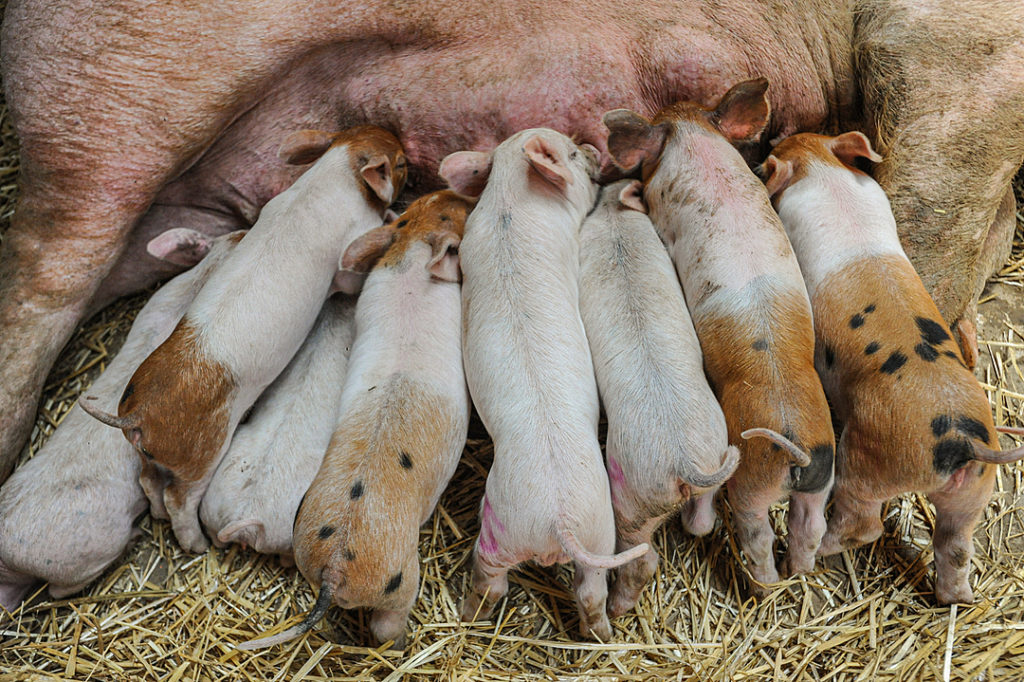
Depending on the age of the piglet, their diet will consist of colostrum, milk, solids, or a combination of milk and solids. Piglets of all ages should have access to fresh, clean water at all times, though for very young piglets, you must prevent them from getting wet and chilled and also must ensure they cannot drown in a water dish.
While young piglets living with their mother will likely have most of their nutritional needs met through nursing, there are situations that will warrant supplemental feeding for piglets. These include if the mother is not producing enough milk; if the mother is not letting the piglet nurse; if the piglet’s siblings are making it difficult for the piglet to nurse as much as they need; if the piglet has difficulty suckling; or if the piglet is not gaining weight appropriately. Be sure to contact your veterinarian if a piglet is having difficulty suckling, shows no interest in eating, or is failing to gain weight.
Colostrum
Recommendations for the amount and frequency of colostrum intake vary widely, so it’s a good idea to check in with your veterinarian to see what they advise.* In lieu of pig colostrum, piglets can be fed a colostrum replacer for cowsWhile "cows" can be defined to refer exclusively to female cattle, at The Open Sanctuary Project we refer to domesticated cattle of all ages and sexes as "cows.", kids, or lambs (not to be confused with a colostrum supplement which, as the name suggests, is meant to be a supplement rather than replacement for colostrum). Be sure to gently warm colostrum to about 100 degrees Fahrenheit (37.8 degrees Celsius).
*How Much Colostrum Do Piglets Need?
According to Farmer, Maes, and Peltoniemi, in Diseases Of Swine, 11th Edition, piglets who are able to nurse from their mother consume an average of 210–370 grams of colostrum per kilogram of birth weight in the first 24 hours. While piglets who are hand-reared will often voluntarily consume more than double that amount, striving to provide approximately that amount can help mimic what they would consume if they were nursing from their mother. However, if you find that it is challenging to get a piglet to consume that much colostrum, the authors cite a 1991 study that found that “Piglets artificially reared and receiving 6 hourly feedings of 25 mL of sow colostrum followed by hourly feedings of cow’s milk had plasmatic immunoglobulin concentrations similar to those of naturally fed piglets at 24 hours of age (Klobasa et al. 1991). Increasing the number of hourly feedings of colostrum from 6 to 12, 18, or 24 did not increase the concentrations of plasma immunoglobulins in piglets.” Based on this and other recommendations from non-compassionate industry sources, it seems that striving for at least 150 milliliters of colostrum, ideally within the first 12-16 hours, should still provide large breed piglets with the antibodies they need. Please note that this information is directed towards large breed pigs commonly raised in agricultural settings – mini pig breeds will consume and require less colostrum given their smaller size.
While the above recommendation cites hourly feedings, most of the caregivers we spoke to strive to feed one-day-old piglets every two hours, including overnight. However, we also connected with experienced caregivers and veterinarians who have found that piglets can go 3-4 hours overnight without eating (and without screaming for food, a tell-tale sign that a healthy piglet is due to be fed – a sick piglet may not show these same signs of hunger, so do not take an absence of screaming or attempting to suckle on you as a sign they are not hungry).
The Dangers Of Bottle Feeding
Bottle feeding carries the risk of aspiration, so we recommend syringe feeding colostrum or providing colostrum in a shallow dish or pan (discussed more below). When syringe feeding, be sure to use a syringe that works well and slides easily. You can place a few drops in the piglet’s mouth, waiting for them to swallow before dripping more into their mouth. Squirting milk too quickly or putting too much in their mouth at once can result in aspiration. Another method recommended by some pig caregivers is to use a clean sponge or the twisted corner of a clean washcloth to soak up colostrum and to encourage the piglet to suck colostrum from the sponge or washcloth. Just keep in mind that with the washcloth technique or pan feeding, there will likely be some waste. Therefore, you will want to offer more colostrum than what they need to account for any waste.
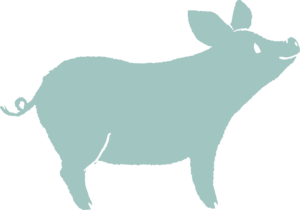
Keep Them Clean!
Feeding time can be messy, so be sure to wipe up milk/colostrum-covered faces, legs, etc. If you have to use a damp cloth to do so, be sure to use warm water and thoroughly dry them off to prevent them from getting chilled!
If a piglet is unable to take in colostrum (or milk) on their own, they will need to be tube fed, which should only be done by someone with experience tube feeding piglets. Piglets are notoriously challenging to tube feed, and improper tubing can result in aspiration or even death. Do not attempt to tube feed a piglet if you are not trained to do so. Individuals who are unable to suckle should be seen by a veterinarian immediately.
Milk
Piglets under 6 weeks of age who are not living with their mother*, or are not able to get sufficient milk from their mother (or from a foster mother), will need to be fed an appropriate milk substitute. When it comes to what to feed, there are a few options. The first option, and a favorite among piglet caregivers, is to feed pasteurized goat’s milk which is available in many grocery stores. If your local grocer does not carry it, you should be able to buy powdered goat’s milk online. While some sources, including the 1991 study referenced above, suggest using cow’s milk, multiple caregivers we spoke to found that this caused more gastrointestinal issues than goat’s milk. Therefore, we recommend goat’s milk and not cow’s milk. Another option is to feed a milk replacer formula. While there are milk replacer formulas made specifically for pigs, it may be easier to find a multi-species formula that has mixing instructions for piglets (such as Manna Pro UniMilk or Sav-A-Calf Ultra 24 Multi-Species – just make sure you are following the proper mixing instructions for piglets). Whether feeding goat’s milk or an appropriate milk replacer, milk should be warmed to about 100 degrees Fahrenheit (37.8 degrees Celsius).
*Early Weaning
While, generally, we recommend including milk in the diet of piglets up until they are 6-8 weeks old, large-scale commercial operations often wean piglets around 3-4 weeks of age, at which time they are removed from their mother and transported to a “nursery barn” or “wean-to-finish barn.” Therefore, depending on the circumstances surrounding a piglet’s rescue, you may find that a piglet younger than 6 weeks of age has already been weaned. If you suspect that a piglet has been weaned and they are eating solid foods well, it’s generally a good idea to maintain them on just high-quality pig food and other appropriate solids (discussed more below). Reintroducing milk into their diet could result in diarrhea.
Depending on where you are located, you may be contacted about piglets who have jumped or fallen from transport trucks (or who are suspected of having done so after being found alone near roadways and showing signs of injury from the fall). These individuals are typically 3-4 weeks of age, have just been weaned, and were on a truck headed for a “nursery” or “wean-to-finish” facility. Folks who have cared for piglets coming from these situations have found that it’s helpful to offer them a variety of food options – both milk and different solids, such as pig pellets (dry and soaked), baby cereal, and a variety of other human baby foods to see what they prefer. Observing their preference for milk or solids can then inform what they are fed going forward (and whether or not milk should be part of their diet).
When piglets are able to nurse from their mother or a foster mother, they will nurse frequently, consuming small, but frequent meals. Therefore, when hand-rearing piglets, it’s ideal to try to replicate these frequent small meals. Newborns should not go very long between feedings, but meals can be more spaced out as the piglet ages. For the first two weeks of their life, plan on feeding piglets milk about every 2 hours, including overnight (though, as we mentioned above, some caregivers have found that piglets can go 3-4 hours overnight without eating – work with your veterinarian to come up with an appropriate feeding schedule, and be sure to observe the piglets closely. If you try to go 3 hours overnight but piglets wake up screaming for food around 2 hours, this is a clear sign that they should be fed more often). Around 2 weeks of age, you can start increasing the daily amount of milk fed and decreasing the frequency of meals (feeding more, but less often, starting with every 3 hours, then every 4, etc.). Around the time they are 5 or 6 weeks old, they can typically be fed three or four times per day until you start the weaning process.
In terms of how much milk to feed piglets, daily intake can vary significantly between piglets (ranging anywhere from 10-30% of their body weight) and depends on their breed, size, and other factors. Unfortunately, unlike the information available for some other species of farmed animalsA species or specific breed of animal that is raised by humans for the use of their bodies or what comes from their bodies., there isn’t agreement between sources regarding how much milk to feed a piglet. When determining the “right” amount of milk to feed them, pay attention to their appetite, weight/body condition, and poop. Individuals who are eager to drink more can be offered more milk as long as they do not have diarrhea. If an individual develops diarrhea, you can slightly scale back on their milk since overeating is a common cause of diarrhea. Be sure to contact your veterinarian if the diarrhea does not resolve, becomes more severe, or if the individual appears weak, dehydrated, or is showing other concerning signs.
We strongly recommend that you connect with an experienced veterinarian to determine the best feeding plan for the specific individuals in your care and that you closely monitor the individual to evaluate whether or not the feeding plan needs to be adjusted. The following information is merely meant to be a starting point and may not be appropriate for every piglet. For large breed piglets under 2 weeks of age, you can start by offering 1-2 ounces per feeding (every 2 hours), increasing the amount as they grow and if they appear eager to eat more (so long as they do not develop diarrhea, in which case, you should scale back a bit). As with colostrum, mini breed piglets will drink less milk than large breed pigs. In Merck Veterinary Manual’s “Feeding and Nutrition of Potbellied Pigs”, Dr. Bruce Lawhorn recommends feeding potbellied piglets approximately 1oz of milk every 4–6 hours, again increasing the amount as the piglet grows and scaling back if they develop diarrhea. However, piglet caregivers we connected with find that feeding mini piglets every 2 hours, as recommended above, works better and this also more closely mimics their feeding schedule if they were able to nurse. Therefore, you may want to divide this up into smaller, more frequent feedings, starting with 10-15 milliliters every 2 hours and going from there.
Pan Feeding
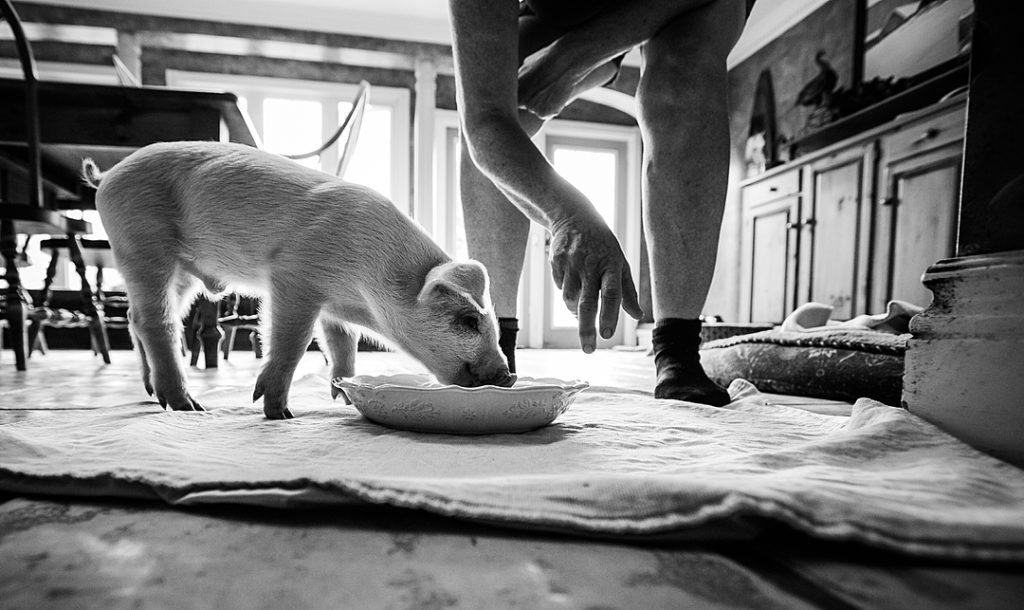
As mentioned above, bottle feeding carries significant risk of aspiration and should typically be avoided. A safer, albeit messier alternative to bottle feeding is to feed milk out of a shallow bowl or pan. You’ll want to place the pan on the ground and ensure it won’t slip (depending on the type of surface under the pan, placing it on a towel or rubber-backed bath mat can help keep it in place, or you might find that weighing it down with something heavy helps to keep it in place). To encourage piglets to eat, you can start by dipping your finger in the milk and placing it on or in their mouth (be careful of those teeth though!). Using your finger to tap the pan can also be helpful. Be patient! It may take a little bit for the piglet to get the hang of it. Piglets will climb right into the dish to eat, so be prepared to clean and dry them off after each meal.
Introducing Solids
You can start offering piglets solid food (in the form of milk-soaked pig(let) pellets or baby rice cereal) around the time piglets are 3 days old, though some caregivers prefer to wait until piglets are a bit older to start introducing pellets. You can also try giving them dry pellets as early as 10 days of age, though you may find that piglets are uninterested in it until they are a bit older. While there are some piglet starter foods out there, and some caregivers have had success feeding Mazuri Mini Pig Youth, specifically, we’ve also talked to caregivers who have had success feeding pig food formulas that are not designed specifically for piglets (or are intended for pigs of all stages of life). Starter food is higher in protein (Mazuri Youth has a minimum of 20% crude protein), but caregivers have had success with pig food formulas that have less protein, such as Ross Mill Farm’s Champion Potbellied Pig Food (minimum 14% crude protein) and Nature’s Match Pig And Sow Food (minimum 16% protein). While some sanctuaries feed a diet even lower in protein to their mature residents, this may not be suitable for growing piglets.
If piglets are living with their mother, they will have access to her solid foods (high-quality pig pellets, fresh veggies, grass hay, etc.) from the day they are born, but they should still be offered their own solid foods. To prevent the mother from eating all of the piglet’s food, you can create an area that the piglet(s) can enter but the mother cannot and provide the food here (discussed more in the Living SpaceThe indoor or outdoor area where an animal resident lives, eats, and rests. Recommendations section below) or you can offer them access to solid foods while she is separated to eat her own food.

Other Solid Foods
As piglets are eating more pellets, you can start introducing a small amount of healthy veggies into their diet. Fruit can lead to diarrhea and is best avoided until they are older. When piglets are strong and healthy enough to go outdoors (so long as the weather is appropriate), they can also begin to root around and eat grass. Dried grass hay can also be provided to piglets early on, though they may not show any interest in it initially.
Weaning
As mentioned above, we recommend continuing to feed piglets milk until they are 6-8 weeks old. As they near this age range, you can work to get them eating more pellets either soaked in their milk or offered separately. Weaning can go a bit more smoothly if piglets are used to eating a milk/pellet mixture, as you can simply start to slowly decrease the milk over the course of a week or two (adding water as needed to maintain the same consistency). Alternatively, if piglets are eating pellets well without the addition of milk, simply scale back on their milk feedings, offering less at their scheduled feedings and eventually cutting out entire meals (i.e. instead of feeding milk 3 times per day, decrease to feeding milk 2 times per day). With both weaning methods, make these changes slowly, aiming for a 2 week period of reducing their milk intake, ultimately eliminating it altogether.
In terms of how much pelleted food piglets should be eating once it is their primary food source, some caregivers have had success free-feeding piglets during their first few months of life before transitioning them to measured portions. Others have found that aiming for 2-3% of their body weight has worked well. The “right” amount is going to depend a lot on the piglet and also the makeup of the pellets, particularly the protein content. While you certainly do not want to be too restrictive, you also must be careful to avoid overfeeding since unhealthy weight gain can predispose pigs to certain health issues. If you started them out on a higher protein diet initially, you’ll want to gradually transition them to a lower protein diet to prevent unhealthy weight gain. We recommend checking in with your veterinarian for their recommendations.
Living Space Recommendations For Piglets
One of the most important aspects of living spaces for very young piglets is keeping them warm. Piglets are not able to regulate their internal body temperature until they are a few days old, and they will not eat well if they are cold. The ideal temperature for piglets during their first few days of life is about 90 degree Fahrenheit (32.2 degrees Celsius), which can then be reduced to 70-80 degrees Fahrenheit (21.1-26.7 degrees Celsius). By the time piglets are about 1 month old, they will typically only require a heat source if they are living in an unheated structure and outdoor temperatures are cold. While keeping them warm is important, piglets can also overheat, so you’ll need to be thoughtful about how you set up their living space and how you provide heat. Piglets should always have room to move away from heat sources if necessary. Be sure to watch closely for signs piglets are too warm or too cold, and make adjustments to their living space accordingly. Huddling and shivering are signs piglets are too cold, and open-mouth breathing is an indication piglets are too warm (though open-mouth breathing can also be a sign of pain or respiratory issues).
Living Spaces For Piglets Who Are Not Living With Their Mother
Living spaces are going to look a bit different depending on whether or not a piglet is living with their mother. First, let’s consider housing for piglets who are not living with their mother. Piglets should have room to move around freely, but should also be kept in a safe space away from anything (and anyone) that could cause them injury or illness. Very young piglets often do best in smaller spaces where they can be kept warm and safe, particularly when they are resting or are not being supervised. Because of their need for warmth as well as the frequent feedings and close observation they require, piglets not living with their mother often do best when housed in human dwellings or in sanctuary caregiver spaces (such as in an office space or an indoor medical area).
While there are various ways one could go about creating a safe space for a piglet within these human spaces, one option is to use a soft playpen designed for human babies or dogs. You want to avoid areas or items in which piglets could get trapped or tangled, especially in the first couple weeks. Blankets can make for comfy, warm bedding, but must be included thoughtfully. When using blankets as bedding in areas with piglets under 1 week old, we recommend setting up the space so that blankets can be tucked under a mat or otherwise secured so that piglets cannot get under them. They do love to burrow, so the addition of a small hand towel or similar-sized soft blanket can be included for this activity. As the piglet gets bigger, you can offer a larger blanket such as a receiving blanket. Avoid using blankets much larger than this and never use a pillow case. Straw or wood shavings can also be used for bedding, though the use of straw might make it difficult to see where piglets are sleeping, so you’ll need to take care if they are in a space large enough for a human to walk or stand in. You could easily step on a sleeping piglet who is buried in straw (which is also why we don’t recommend straw initially for very young piglets who are still with their mother – more on this below).
Unless the ambient temperature is already at a suitable range, you’ll need to include some sort of heat source. We like to steer folks away from using heat lamps due to the associated fire risk and instead recommend other heat sources, in particular microwavable heat discs wrapped in a blanket or otherwise covered (though these might not provide enough warmth on their own in some settings). Some microwavable heat discs fit into specially designed stuffed animals which then allow piglets to snuggle up to a warm “companion.” This can provide both physical and psychological comfort to the piglet, especially if they are living alone. If using a heating pad, you must ensure the piglet cannot chew on the cord and, like the microwavable heat disc, you should cover it so that the piglet does not come in direct contact with it. If opting for a space heater, this should be set up outside of the piglet’s living space and away from flammable items. Position the heater so that it heats only a portion of the piglet’s living space, allowing them to move into a cooler area if they wish.
If you feel a heat lamp is your only option to keep piglets properly warm, we strongly recommend using a ceramic bulb lamp rather than a glass bulb lamp. Make sure it is held securely in place and is away from flammable materials.
Living Spaces For Piglets Who Are Living With Their Mother
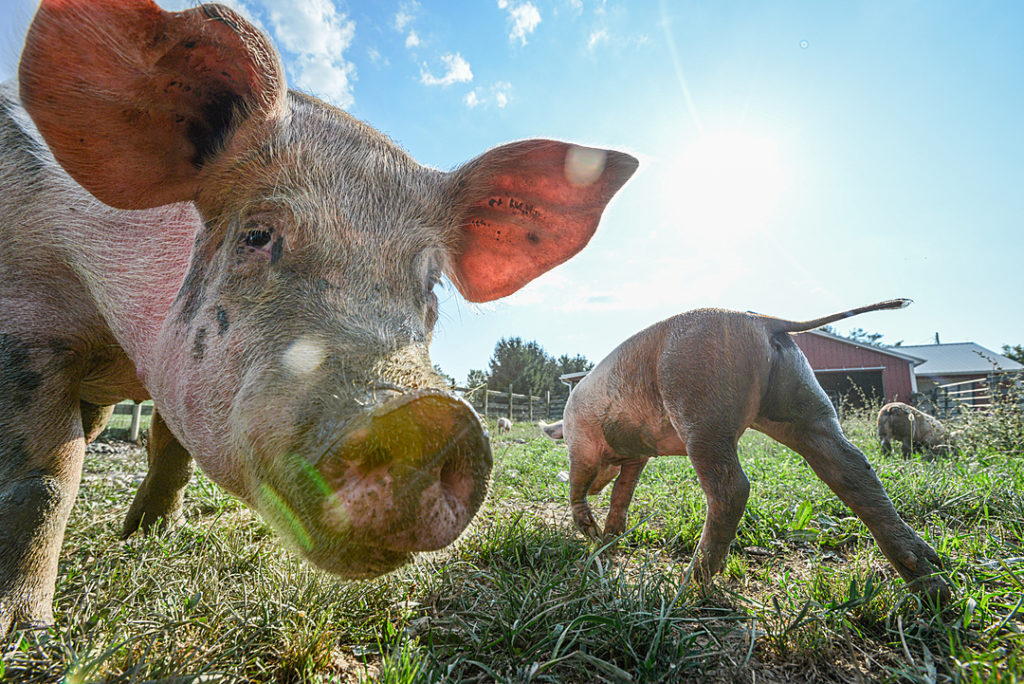
As we mentioned earlier, if piglets are living with their mother, they should not be separated unless absolutely necessary for the health and well-being of mother or baby. However, it can be helpful to create an area of the living space that is setup specifically for the piglet(s). This might be an area that the piglets can come and go from but the mother cannot (created by including a sturdy barrier with a piglet-sized entry to the space), or you might simply set up a corner of the living space for piglets to use if they wish (but without any sort of physical barrier that prevents mom from being in this space). Whenever a physical barrier is used to create a separate space, you must make sure it is sturdy and secure and that piglets can easily move from this area into the main area.
While very young piglets require warm temperatures, heating the main living space to the temperatures described above will result in mom being too hot. She’ll be most comfortable in spaces that are 60-65 degrees Fahrenheit (15.6-18.3 degrees Celsius). You can ensure everyone’s comfort by keeping the main space cooler and providing a safe heat source (such as a microwaveable heat disc) in the piglet area so that they always have a warm space they can go to. If they are snuggled up with mom and their siblings, they’ll stay pretty warm, but when she’s up and active, they may become chilled and will benefit from having the option to move to a warmer area. As mentioned above, when choosing a heat source, be sure to consider any safety risks involved. Heat sources that work for piglets who are without their mother may pose a risk in situations where mom is present. For example, while it may be easy to protect a heating pad cord from piglets, mom may find a way to access and chew this cord, which is a safety risk.
In terms of bedding for piglets who are living with their mother, we recommend avoiding straw until piglets are at least a few weeks old. A piglet who is sound asleep under the straw is easy to miss, increasing their risk of being stepped on by mom or a caregiver. Wood shaving will make it easier to see where piglets are sleeping. If adding blankets, you can follow the guidance above regarding blanket safety.
As mentioned above, while it’s always good practice to reduce stress where you can, when piglets are living with their mother, you must be especially cognizant of keeping everyone calm. A screaming piglet can quickly result in an agitated and fast-moving mother, which can not only pose a safety risk to humans, but can also put piglets at risk of being accidentally stepped on. While there may be times when you cannot avoid an activity that may cause a piglet to protest loudly, you must take steps to ensure everyone’s safety before conducting such an activity. This typically means separating mother and babies temporarily. We recommend coordinating with mom’s meal time or giving her other tasty treats. While she will still likely become agitated if one of her babies screams, having food may at least make the initial separation less stressful.
Ventilation Is Imperative!
Appropriate ventilation is key for pigs of all ages – poor ventilation is a common cause of pneumonia. Be sure to keep spaces draft-free and dry and offer appropriate heat sources as needed, but avoid creating spaces that are too humid.
Venturing Outdoors
The weather and the overall health of the piglet will dictate when they can start spending time outdoors, as will your setup and whether or not piglets are living with their mother. We typically recommend waiting until piglets are at least a few weeks old before giving them time outdoors, but you may find that it makes sense to give them outdoor access earlier than this if the weather is warm, particularly if piglets are living with their mother. Piglets are much more vulnerable to predation than mature pigs, so be sure to closely supervise their time outdoors and ensure the space they are in is safe. Keep in mind that fencing that is appropriate for mature pigs may have gaps that piglets can fit through or under. You must ensure that the area can keep piglets safely contained before giving piglets access to the space.
Keep in mind that light-skinned pigs can easily get sunburned, so provide ample shade and sun protection.
Social Considerations For Piglets
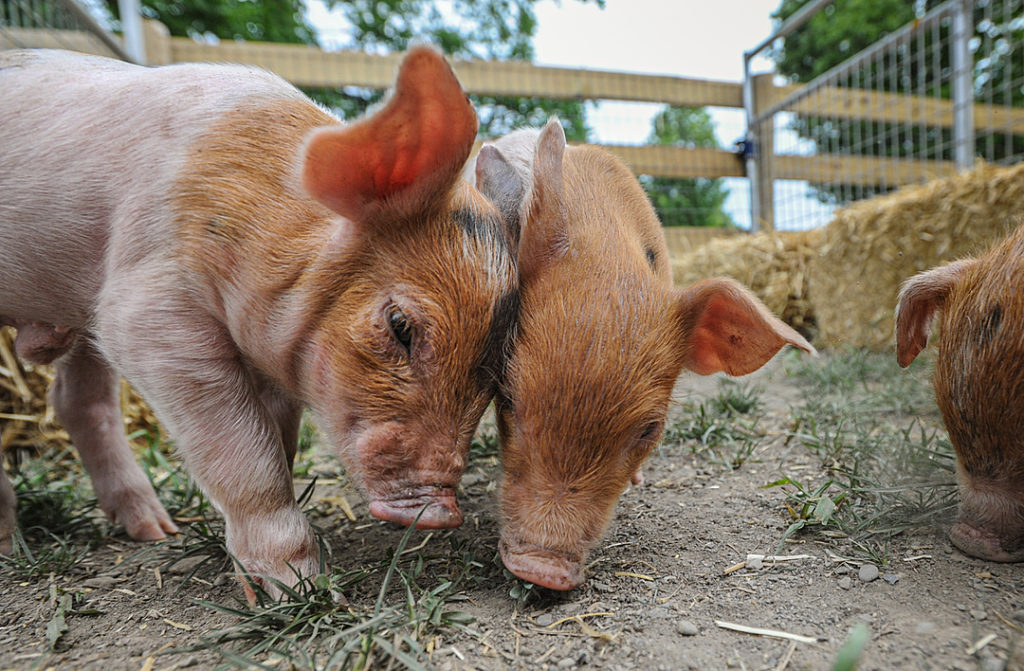
Pigs are social animals who typically do well living with other pigs. However, there are a variety of reasons why caregivers may deem it necessary to wait for a piglet to grow up a bit before introducing them to other pigs. This decision depends on many factors including their health, whether or not they are with their mother, your sanctuary’s Philosophy of Care, the temperament of your pig residents, and your pig residents’ living space.
It is imperative that you wait until the new individual has finished their quarantine period and has been deemed healthy enough to be introduced to other pigs. Additionally, you want to consider the following:
- Would introducing them to other pigs and/or moving them into your pig residents’ living space interfere with the care the piglet needs? For example, would it be difficult to keep them properly warm or feed them an age-appropriate diet in the new space?
- Are there safety issues associated with the new living space or with members of the pig herd? This includes, but is not limited to, the risk of predation, the risk of being trampled or otherwise injured by another pig resident, and the risk of escape if fencing is not suitable for piglets.
- Does introducing them to other pigs make breeding a possibility?
If the answer to any of these questions is “yes”, then it’s not yet time to move piglets in with other pig residents. You may need to wait for piglets to grow up a bit, and/or you may need to make some changes to the living space before being able to safely move them in with other pigs. For piglets who are not living with their mother, it’s often easiest to wait until the piglet is fully on solids (around 8 weeks of age) before thinking about moving them in with other pigs. However, if you have rescued more than one piglet, but they did not come in together, introducing them as soon as they complete quarantine, even if they are still on milk, may work well. This will allow the piglets to have companionship and (when they are ready) can make introducing them to your other pig residents easier. Additionally, there have been instances where an older pig resident who is living alone due to the death of a companion has welcomed the companionship of a piglet. Each situation and individual is unique, so you’ll need to make decisions on a case-by-case basis.
In terms of introductions involving a mother and her piglets, you’ll have the added consideration of how mom handles the transition. In some cases, she may be craving time with other pigs (especially if there are other pigs she knows, such as in the case that she was rescued with a group of pigs whom she lived with before being separated to give birth). However, if she is spending a lot of time protecting her babies from perceived threats or appears agitated around other pigs, you should consider waiting until the piglets are a bit older before introducing the group to other pigs. Some sanctuaries that have taken in a mother with babies (or a pregnant pig who gave birth at the sanctuary) have established a separate herd with the new mother and her babies rather than introduce them into another group.
As with all introductions, you’ll need to carefully consider what makes the most sense for the specific individuals you are caring for, and you must closely observe the introduction and transition period, making changes if something appears not to be working out. In some cases, you may find that a piglet can spend the day with other pigs but requires separate accommodations overnight in order to keep them safe from predators or from other residents or in order to keep them properly protected from inclement weather.
Common Piglet Health Challenges
When caring for piglets, it’s important to be familiar with some of the more common health challenges they face. If you have any concerns about a piglet in your care, contact an experienced veterinarian for guidance. The following is not an exhaustive list but offers an overview of some of the health challenges a piglet caregiver may come across.
Diarrhea (Scours)
There are a variety of potential causes of diarrhea in piglets ranging from infectious disease to overeating. While mild diarrhea caused by overeating may be quickly remedied by reducing the individual’s milk intake, diarrhea caused by other factors can result in serious illness. We strongly recommend you connect with your veterinarian if a piglet has watery diarrhea, diarrhea combined with other concerning signs (weight loss, sunken eyes, lethargy, anorexia, etc.), or if diarrhea persists for longer than 48 hours. They can help determine the underlying cause (though this usually requires fecal testing as well), establish an appropriate treatment plan, and provide supportive care as needed. Diarrhea-causing pathogens in young piglets include but are not limited to, Escherichia coli, rotavirus, Clostridium difficile, Clostridium perfringens types A and C, Isospora suis (coccidia), and Cryptosporidium spp. Depending on the cause, treatment may consist primarily of supportive care or your veterinarian may recommend other treatments, such as dewormers or antibiotics. To address dehydration, your veterinarian may recommend providing the piglet with electrolytes. If the piglet is too weak to accept fluids orally, your veterinarian may need to start intravenous or rectal fluids.
Ensure that the piglet is kept warm and dry. If an infectious cause is suspected or confirmed, be sure to keep them isolated from other pigs during recovery, and continue to practice good biosecurity habits to protect the rest of your residents. One exception here is if the piglet is living with their mother. We recommend having a discussion with your veterinarian about whether or not the two must be separated and to weigh the risks of separation with the risks posed by leaving them together.
If the cause of the diarrhea is zoonotic, you must take all appropriate measures to ensure that no human is exposed directly to their fecal matter. Do not let a piglet with diarrhea interact with the public! It is imperative that everyone working with or around the piglet wears gloves and avoids touching their face until their hands are thoroughly washed.
Constipation Is A Concern Too!
It’s not just diarrhea that is a problem – you also need to look for signs of constipation. If a piglet is straining to defecate, is not passing stool regularly, or has hard stool, be sure to contact your veterinarian right away. In addition to determining the cause and making adjustments to their diet if needed, your veterinarian may also start the piglet on a laxative and/or perform an enema.
Pneumonia And Other Respiratory Diseases
Pneumonia is a respiratory disease caused by inflammation in the lungs. Piglets can develop pneumonia from a variety of causes including environmental factors (high humidity, poor ventilation, and/or being exposed to extreme temperature fluctuations) and aspiration (which is a significant risk with bottle feeding and is why we recommend against it). It can also be caused by a variety of organisms including bacterial, viral, parasitic (namely roundworms and lungworms), or a combination of these. As stated above, poor ventilation is a common cause of pneumonia, so be sure to offer appropriate ventilation in piglet living spaces, and be sure to keep living spaces clean since ammonia build-up can also lead to pneumonia. Piglets who did not receive sufficient immunoglobulins from colostrum are especially vulnerable to developing pneumonia. Signs of pneumonia may include fever; coughing; shallow, rapid breathing (also called “thumping”); open-mouth breathing; gurgly or wet sounding breathing; a dull appearance; lethargy; a poor appetite; and rectal prolapsethe falling down or slipping of a body part from its usual position or relations. Piglets showing signs of pneumonia should be assessed by a veterinarian as soon as possible. Your veterinarian will be able to recommend appropriate diagnostics (such as blood work, a fecal analysis, and/or an ultrasound of their lungs) and can also recommend an appropriate treatment plan. Without proper treatment, piglets can die from pneumonia, and those who recover can suffer from permanent damage to their lungs.
Pneumonia is not the only respiratory disease that can affect piglets. They can also develop upper respiratory tract infections. Many of the viral diseases that affect the upper respiratory tract are contagious and potentially fatal. It is imperative that you work with an experienced veterinarian to have a piglet showing signs of respiratory illness evaluated. Your veterinarian can perform the necessary diagnostic tests to determine the underlying cause. Be sure to contact your veterinarian if you see any of the signs listed above or if a piglet has nasal or ocular discharge, blood coming from their nose, labored breathing, an elevated respiratory rate, or is sneezing.
Umbilical Hernia
While not necessarily a common condition in piglets, generally, it is not uncommon for sanctuaries to be contacted about piglets with umbilical hernias whose “owner” is either unwilling or unable to cover the cost of surgical repair. If a piglet arrives with an umbilical hernia or develops one while under your care, contact your veterinarian immediately. Left untreated, this condition can result in intestinal strangulation and death, so prompt veterinary assessment is imperative. While there is evidence to suggest that some umbilical hernias are hereditary, they can also be the result of improper navel care and resultant infection, which is just one of the many reasons that it’s important to keep this area clean.
Hereditary And Congenital Abnormalities
While hereditary and congenital abnormalities can occur in any piglet, including large breed pigs, inbreeding is leading to more abnormalities in mini pigsThe term “mini pig” is used to categorize smaller breeds of pigs, such as Potbellies, Julianas, and Kunekunes, and to differentiate between these breeds and large breed pigs, such as Yorkshires, Landrace, or Hampshires, who are sometimes referred to as “farm pigs”. The descriptor “mini” can be a bit misleading- some breeds of mini pigs can weigh over 200 pounds! Terms like “teacup”, “micro”, “pocket”, “nano”, and “micro mini” are deceptive terms that are sometimes used to intentionally mislead people into thinking an individual pig will remain a certain size.. Given the fact that sanctuaries are often contacted about individuals with health issues, it is not uncommon for a sanctuary to be contacted in the case of a piglet with a hereditary and/or congenital abnormality. There are a variety of abnormalities one might encounter, each with its own prognosis and care requirements. These include, but are not limited to cleft palate, atresia ani (abnormality of the anus or rectum), foot and legs issues (such as joint contractures, splayed legs, or “mule foot” – uncloven hooves similar to an equine rather than the cloven hooves of a pig), and hernias (scrotal, inguinal, or umbilical). Be sure to work with an experienced veterinarian to determine the best course of action based on the specific abnormality/abnormalities, the severity, the individual’s overall health, and your ability to provide necessary care. It can also be helpful to connect with experienced caregivers who have cared for individuals with similar conditions, as they may have additional insight in regards to their care and the impacts the condition has on quality of life. For example, you may find that a veterinarian suggests euthanasiaThe act of ending someone’s life to spare them from suffering or a significantly reduced quality of life that cannot be managed. for a particular congenital abnormality, but that an experienced caregiver has had success caring for individuals with a similar condition.
Greasy Pig Disease (Exudative Epidermitis)
Greasy Pig Disease is a bacterial skin infection caused by Staphylococcus hyicus. This bacterium is commonly found on pigs’ skin without causing disease, but damage to the skin from injury or another disease (such as mange) can result in development of Greasy Pig Disease. Greasy Pig is often seen secondary to the industrial farming practices of clipping needle teeth and docking tails. The disease is most commonly seen, and is also most severe, in piglets under 8 weeks of age (and can be fatal, especially in piglets who are just a few days old). In piglets, the disease typically manifests as reddened skin that develops brown or black scabbing starting in the area of the face, neck, and shoulders and then spreading to other areas, though in some cases the lesions may start at the feet and spread up the legs. Affected piglets will have skin that is discolored and greasy, hence the name. Piglets may become lethargic and depressed with a decreased appetite. The condition is often diagnosed based on the appearance of the lesions, but a culture can confirm the diagnosis and identify the best antibiotics to use. Treatment consists of systemic antibiotics and sometimes topical antibiotic treatments as well. Cleaning the skin with a pig-safe disinfectant can also be helpful. When caring for piglets with Greasy Pig, it is important to ensure they stay properly hydrated – your veterinarian may recommend providing the piglet with electrolytes. Be sure to consult with your veterinarian if you suspect a piglet has Greasy Pig. The younger the piglet, the higher the risk of death, so consult with your veterinarian immediately. Proper sanitation and ventilation, as well as protecting piglets from injury can help prevent this disease.
Parasites
Depending on where the piglet came from, their risk of having been exposed to internal and/or external parasites may be high.
Internal Parasites
We recommend incoming fecal testing for all new residents, and piglets are no exception. There are a number of internal parasites that can affect piglets, with some occurring worldwide and others occurring more often in certain regions or climates. We recommend you work with your veterinarian to establish incoming fecal screening for new piglets. While far from the only parasites that are a concern in piglets, two of the more common internal parasites that affect piglets are Isospora suis (coccidia) and Ascaris suum (large roundworm).
Coccidiosis caused by Isospora suis is most often seen in piglets who are 1-3 weeks old. Affected piglets will develop foul-smelling diarrhea that is watery or greasy. They may become weak and dehydrated, struggle to gain weight, have a rough-looking coat, and vomit up their milk. In more severe cases, piglets can die from the disease. Fecal testing can sometimes confirm coccidiosis, but if samples are taken too early or too late in the disease process, they may not reveal many oocysts (eggs). Collecting fecal samples two to three days after an individual is showing signs of illness may be best. Be sure to consult with your veterinarian if a piglet is showing signs of coccidiosis.
A. suum is the most common internal parasite of pigs and causes the most severe disease in piglets. Eggs hatch in the intestine after being ingested by a pig. Larvae then penetrate the wall and can spread to the liver, lungs, and other areas. Once in the lungs, eggs are coughed up, swallowed, and return to the intestines where they mature. Eggs will begin to pass in the feces 6-8 weeks after infection. Before this time, a fecal float will not be reliable. In piglets, A. suum infections result in inflammation in the intestines, and ascarids will compete with the host piglet for nutrients, resulting in slowed growth or weight loss. Infections can also result in interstitial pneumonia, scarring of the liver, secondary bacterial infections, and mechanical obstruction of the intestines. Symptoms of A. suum infections include slowed growth, rough coat, “thumping”, chronic coughing fits, and a pendulous abdomen. In some cases, mature worms may be found in feces making diagnosis easy. There is evidence that this parasite is zoonotic, so be sure to take precautions when working with piglets with suspected infection. Eradication of A. suum can be difficult because eggs can survive in the environment for years under the right conditions, so be sure to work closely with your veterinarian not only to treat the individual(s) who are ill but also to prevent future infections.
External Parasites
In addition to internal parasites, piglets can also be infested with lice and mites. The species of louse that affects pigs is large, so you should be able to determine fairly easily if a piglet has a louse infestation. The most common areas to find lice are the ears (where they often live), neck, and insides of their legs. Piglets with lice infestations may appear restless, itchy, and agitated. They may lose their hair and develop dermatitisDermatitis refers to skin irritation. This may include itchy, dry skin or a rash on swollen, reddened skin. It may also cause the skin to blister, ooze, crust or flake from constant scratching and rubbing. Left untreated, piglets could become dangerously anemic from louse infestations. Be sure to consult with your veterinarian for the most appropriate treatment plan.
Pigs can be affected by two types of mange mites but sarcoptic mange, caused by Sarcoptes scabiei var suis, is the most common. S. scabiei var suis mites are spread from pig to pig via direct contact or through fomites. They start out in the ear and then spread to the rest of the body. These mites burrow into the skin to lay their eggs, causing irritation to the skin resulting in frequent rubbing, scratching, and head shaking of affected pigs. In many pigs, an allergic hypersensitivity develops 2-3 weeks later resulting in even more rubbing and scratching, which causes further damage to the skin. Affected piglets will develop thickened, wrinkled skin that may have white or gray patches. Be sure to contact your veterinarian if you suspect a piglet has mange. Mites can be confirmed via skin scrapings, with the inside of the ear being the best location to sample. Even if only one individual in a group is showing signs of mange, all members of the herd should be treated. Because treatment options do not kill mite eggs, treatments should be repeated 10-14 days after the initial treatment. Your veterinarian will be able to recommend an appropriate treatment plan.
Though sarcoptic mange is sometimes called “scabies,” it is not the same as the mite that causes scabies in humans. People coming into direct contact with piglets with severe mange could get mites on them, and these mites can cause skin irritation, but they cannot reproduce on a human and will die within a few days.
Growing Up
As a piglet matures, their needs change, so be sure to familiarize yourself with the proper housing, diet, and general care pigs require so that you can continue to meet their needs in every stage of their life! Of particular note, you’ll want to ensure you adjust their diet so as to provide the nutrients they need without putting them at risk of unhealthy weight gain, and you’ll also want to pay close attention to their hooves, keeping them trimmed and addressing issues early.
What Does ‘Unacceptable’ Mean?
At The Open Sanctuary Project, unacceptable means that we cannot condone (or condone through omission) a certain practice, standard, or policy. See a more detailed explanation here.
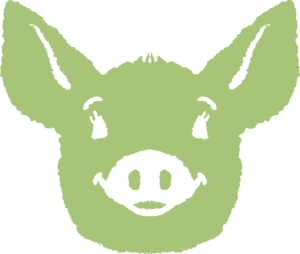
Article Acknowledgments
Special thanks to the folks at Kanda Farm Sanctuary, Hog Haven Farm, and Pig Placement Network for sharing their experience caring for piglets with us.
SOURCES:
Feeding and Nutrition of Potbellied Pigs | Merck Veterinary Manual
The Orphan Piglet | Shepherd’s Green Sanctuary
Coccidiosis of Pigs | Merck Manual
Ascaris Suum In Pigs | Merck Manual
Underaged Mini Pigs | Mini Pig Info (Non-Compassionate Source)
Baby Pig Management – Birth to Weaning | Swine Extension (Non-Compassionate Source)
No Milk Is The Same – Yet Piglets Like It All | Pig Progress (Non-Compassionate Source)
Evaluation of Immunoglobulin G Absorption from Goat Colostrum by Newborn Piglets |Martínez Miró S, Naranjo S, Madrid J, López MJ, Sánchez CJ, Segura MM, Hernández F. (Non-Compassionate Source)
Diseases Of Swine, 11th Edition (Non-Compassionate Source)
The Breeders Code Of Ethics | American Mini Pig Association (Non-Compassionate Source)
Diarrheal Diseases | Iowa State University (Non-Compassionate Source)
Swine Pneumonia | Dr. Bruce Lawhorn (Non-Compassionate Source)
Breeding Responsibly – Concerns of Hereditary Defects | American Mini Pig Association (Non-Compassionate Source)
Exudative Epidermitis – Greasy Pig | Iowa State University (Non-Compassionate Source)
Greasy Pig Disease (Exudative Epidermitis) | The Pig Site (Non-Compassionate Source)
Greasy Pig Disease | National Animal Disease Information Service (Non-Compassionate Source)
Coccidiosis | Iowa State University (Non-Compassionate Source)
Roundworm Infection (Ascariasis) | Iowa State University (Non-Compassionate Source)
Louse Infestation (Pediculosis) | Iowa State University (Non-Compassionate Source)
Ectoparasites | The Pig Site (Non-Compassionate Source)
Non-Compassionate Source?
If a source includes the (Non-Compassionate Source) tag, it means that we do not endorse that particular source’s views about animals, even if some of their insights are valuable from a care perspective. See a more detailed explanation here.
References To Outside Organizations?
This resource contains links or photos provided by an outside animal-focused organization. You can learn about our organization’s position on endorsements here!






